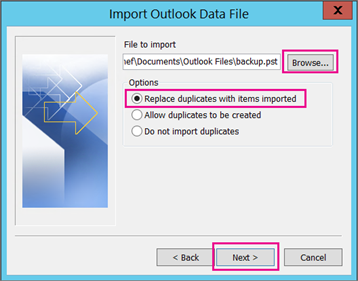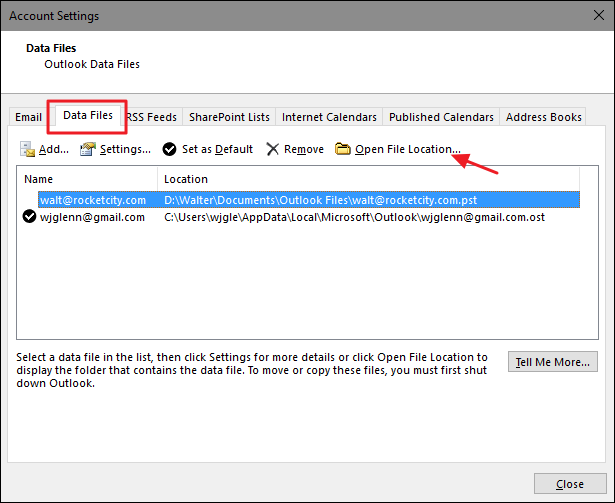Access Pst Files In Outlook
Open and find items in an Outlook Data File (.pst) - Search another Outlook data file In Outlook on your desktop (Outlook 2016, Outlook 2013, Outlook 2010). Choose the Outlook data file you want to open. Expand the top level of the Outlook data file in the Outlook Navigation pane to see. One way to restore your emails from a backup is via a.pst file. To import the.pst file, follow the steps below: Open Outlook 2013. Click on 'File'. Learn how to open a PST file without Outlook. OST PST Viewer is the PST file management software for opening multiple PST files.
I was upgrading from Microsoft Office 2010 to 2016 last week and their INSTALL failed, with error messages 'MICROSOFT OFFICE PROFESSIONAL PLUS 2016 ENCOUNTERED AN ERROR DURING SETUP' and then 'MICROSOFT BOOTSTRAP LOADER HAS STOPPED WORKING'. Days of calling MS and following all their BLOGS have failed so far, and now I have NEITHER Program on the computer, leaving me with only an EXPORTED 11GB PST file that I made just before beginning. It holds 15 years of contacts and emails that I need to reference every week and I cant wait anymore for MS to help with an INSTALL FIX. I will get it fixed HOWEVER in the short term, I have Thunderbird installed, but their latest version wont import PST files anymore, so I need to IMPORT my large PST file into a GMAIL account that I will setup and use for awhile (or later EXPORT to a MBOX file that I can IMPORT into Thunderbird).
Can GMAIL directly IMPORT a 11GB file in a single shot WITHOUT OUTLOOK, or a simple 3rd party program to do so?
Is there a simple program that can CONVERT a PST file to an MBOX file WITHOUT OUTLOOK?
- Is there a simple PST READER that I can use to simply READ my PST CONTACT Data and Notes for a short time until I can get Office 2016 Installed?
Thanks
2 Answers
G Suite Migration for Microsoft Outlook.
You can migrate email, contacts and calendar data from Microsoft Outlook profiles and PST files to G Suite. Use this link to download G Suite Migration tool.
(ask the Word installation question...maybe some here would be able to help...)
I would recommend you to use the free software MailStore Home http://www.mailstore.com/en/mailstore-home-email-archiving.aspx
It can import (archive) from all kind of files/programs/services including PST files, and then it can export it to a whole range of programs/services including to a Gmail account or Thunderbird.
- Download the program from their site and install it. (During installation you can, if you want, choose to do a portable installation in a directory instead of in the system.)
- Open the program, click on Archive E-mail and in there on Microsoft Outlook PST File.
- Browse to the PST file, select it and press Open then Next. And complete the backup.
- After backup presses is completed go to My Archive, right-click on this backup and go to Export To and select the place you want it exported to. (I would say exporting it straight to Thunderbird would be a better idea since it is all offline, and you aren't subjected to some problems Gmail sometimes makes for imports.)
protected by Community♦Feb 24 '18 at 8:44
Thank you for your interest in this question. Because it has attracted low-quality or spam answers that had to be removed, posting an answer now requires 10 reputation on this site (the association bonus does not count).
Would you like to answer one of these unanswered questions instead?
Not the answer you're looking for? Browse other questions tagged gmailimportpstmicrosoft-office-2016mbox or ask your own question.
//If there’s only one copy of something – say a photograph on a mobile phone – then it’s not backed up. If that device were to fail or be lost, then the photograph would be lost forever as well.
Computers are excellent at making copies of digital data, and backups are one important use of that functionality.
It’s generally recommended that important data be backed up in at least one, ideally more, separate devices or media, such as an external hard disk. In addition, it’s recommended that critical data also be backed up in another physical location, such as a different building, or online.
More than anything, the important concept is that there never be only a single copy of important data. That’s not backed up.
See also: back up
(Click on the term for full definition.)
In addition to email, PST files contain calendar, contacts, notes, journal and other information that is used and manipulated by Outlook.
The advantage of the PST is that it is a single file; all information can be copied to another machine or backed up simply by operating on that single file.
The disadvantage of the PST is that it is a proprietary file format readable only by Outlook. It’s also a relatively complex format – almost a complete file system – and as a result can occasionally suffer from corruption and accompanying data loss. Microsoft provides the utility “scanpst” to scan and repair PST files suspected to have issues.
(Click on the term for full definition.)
PST stands for “pst [Personal STore]
In addition to email, PST files contain calendar, contacts, notes, journal and other information that is used and manipulated by Outlook.
The advantage of the PST is that it is a single file; all information can be copied to another machine or backed up simply by operating on that single file.
The disadvantage of the PST is that it is a proprietary file format readable only by Outlook. It’s also a relatively complex format – almost a complete file system – and as a result can occasionally suffer from corruption and accompanying data loss. Microsoft provides the utility “scanpst” to scan and repair PST files suspected to have issues.
(Click on the term for full definition.)
 '>Personal STore” – as in your personal mail storage. PST files are actually fairly complex databases that contain your mail, your calendar, your contacts, and even more when you use Microsoft Office’s Outlook mail program. (Not to be confused with Outlook.com, the online mail service from Microsoft, which is completely unrelated
'>Personal STore” – as in your personal mail storage. PST files are actually fairly complex databases that contain your mail, your calendar, your contacts, and even more when you use Microsoft Office’s Outlook mail program. (Not to be confused with Outlook.com, the online mail service from Microsoft, which is completely unrelated .)
.)The default location has changed a time or two over the years. Of course, there’s always a chance that your PST is stored in some other, non-default location.
Rather than telling you where the default location is, let’s use Outlook itself to tell you the exact path of your PST file and then use Windows itself to do the same.
Using Outlook
I’m using Outlook 2013, but the technique is similar for older versions.
The easiest and quickest way that I know of is to open the “tree view” of your folders, if you haven’t already. The default view is often something similar to this:
Underneath the File menu is a rightward pointing arrow (>). Click that to expose the full-folder pane:
Each top level item represents a separate PST. In the example above, *****@yahoo.com is a Yahoo! email account configured in Outlook 2013, and *****@gmail.com is a Google mail account which has been given its own PST file. In other versions of Outlook, you may see things called Personal Folders or Outlook Today. You may also see additional top-level entries for other email accounts or PST files that you have opened manually.

The key is that each top-level item represents a separate PST.
To find out about that PST, right-click on the top level item and then select Properties:
That will give you the Properties dialog for that specific PST file:
Now click the Advanced… button:
And there, right in the middle of everything, is the Filename and the full path to the PST. If it’s too long to display in the allotted space, you can click in the item and arrow back and forth to scroll the text right and left.
Using Windows
A PST is just a file, so using Windows own built-in search for files with the .pst [Personal STore]
In addition to email, PST files contain calendar, contacts, notes, journal and other information that is used and manipulated by Outlook.
The advantage of the PST is that it is a single file; all information can be copied to another machine or backed up simply by operating on that single file.
The disadvantage of the PST is that it is a proprietary file format readable only by Outlook. It’s also a relatively complex format – almost a complete file system – and as a result can occasionally suffer from corruption and accompanying data loss. Microsoft provides the utility “scanpst” to scan and repair PST files suspected to have issues.
(Click on the term for full definition.)
In Windows 8, I simply started typing *.pst at the Start screen, which means any file that ends in .pst:
I realize that it’s a little difficult to see above, but underneath the search box that appeared as soon as I started typing, I click Files to limit the search result to files (as opposed to Apps or Settings). The result is that on the left, any PST files found are displayed.
Hover the mouse over (or tap-and-hold) on a result for more details:
How To Access Pst Files In Outlook
And of course, those details include the file’s location.